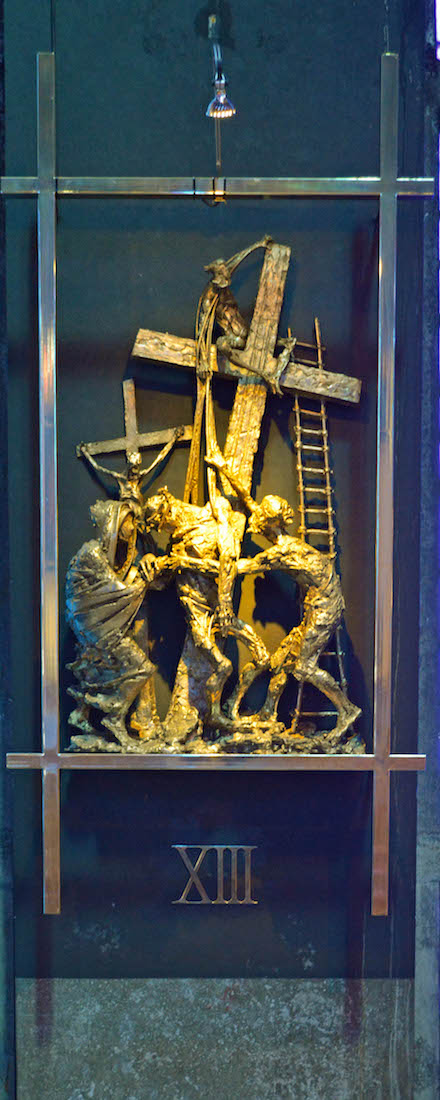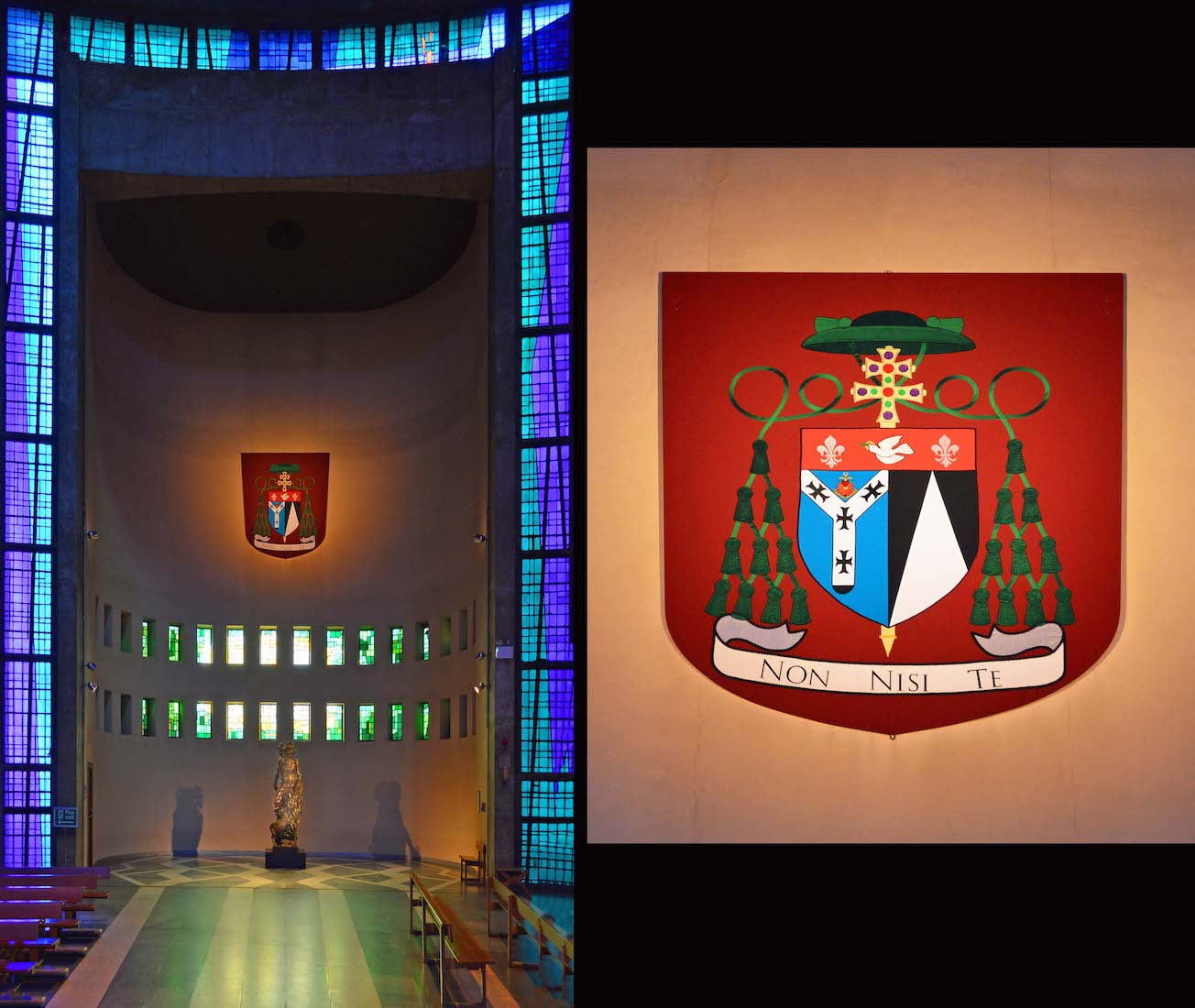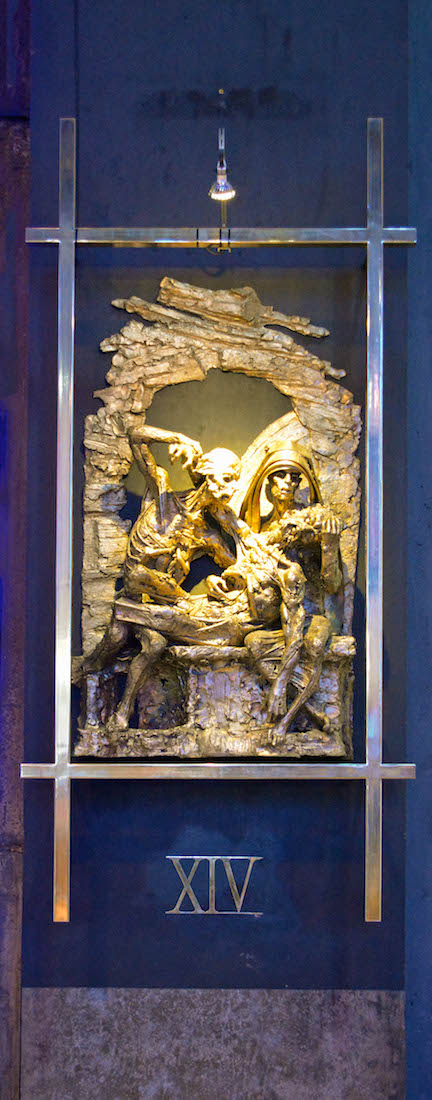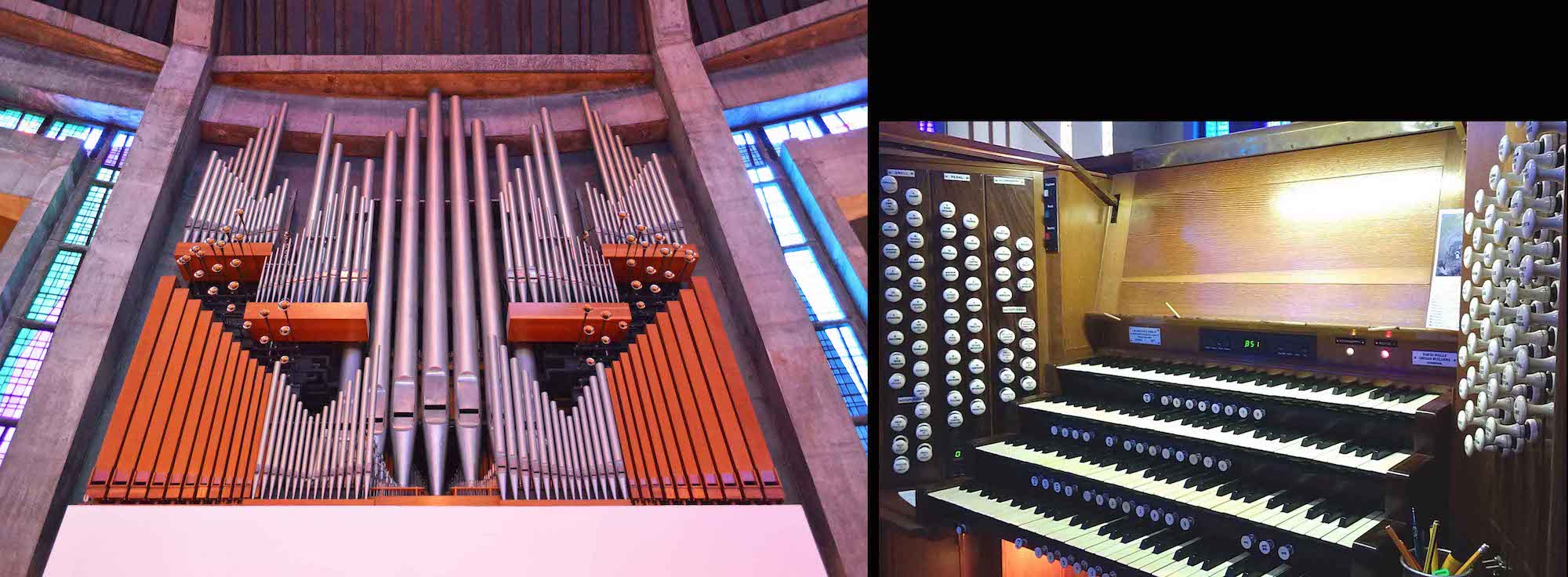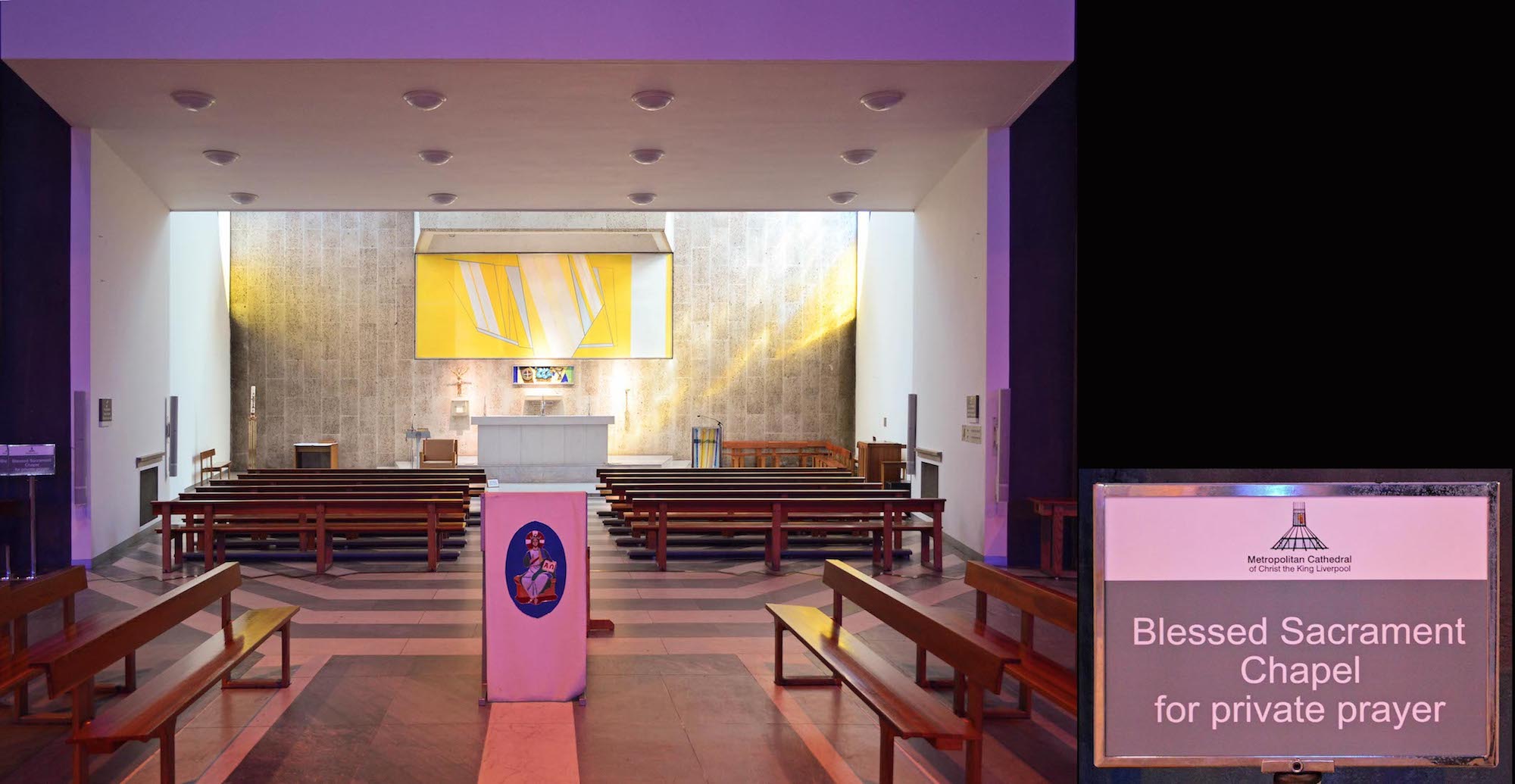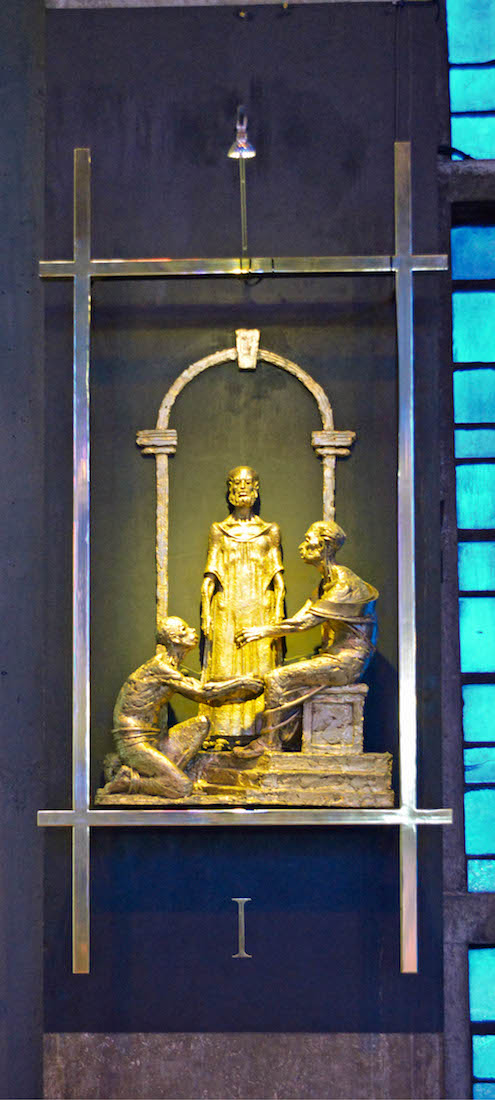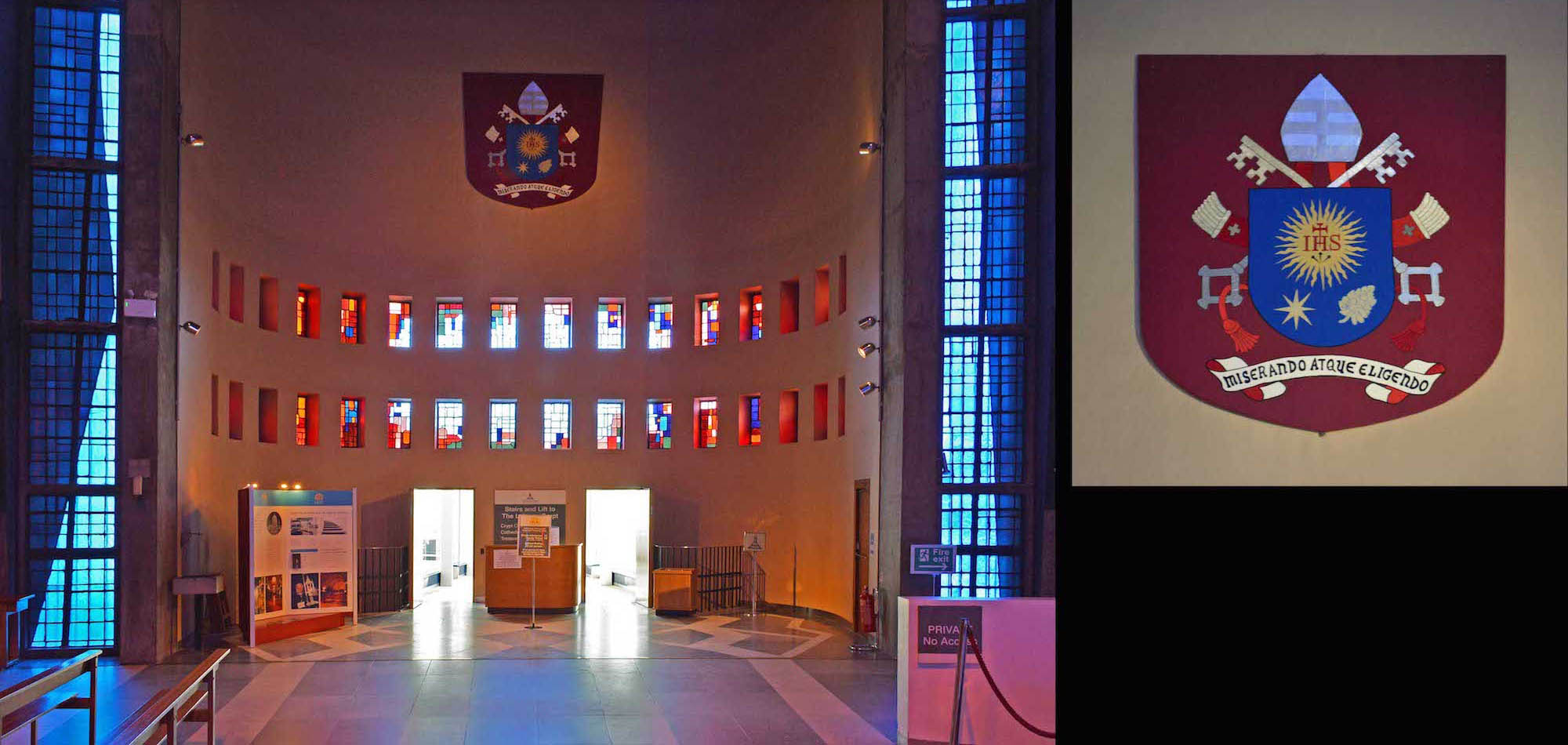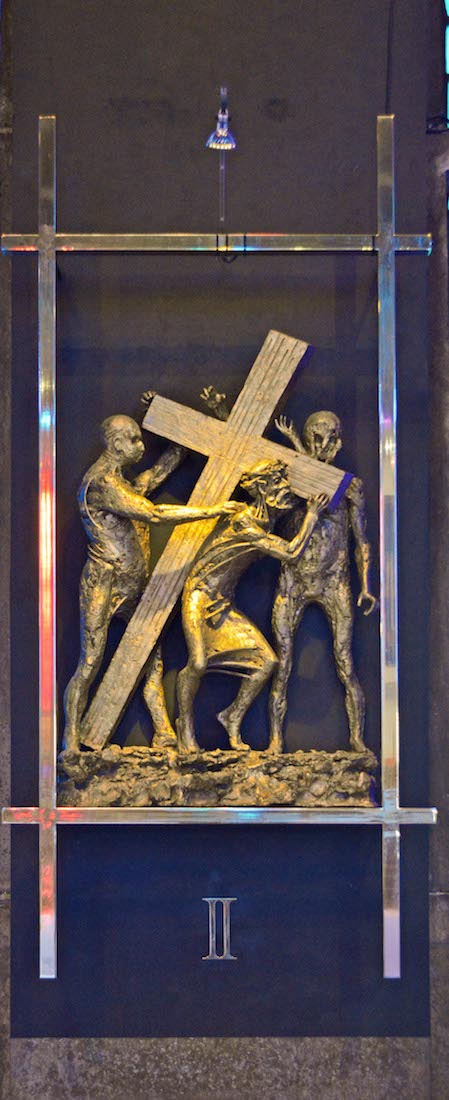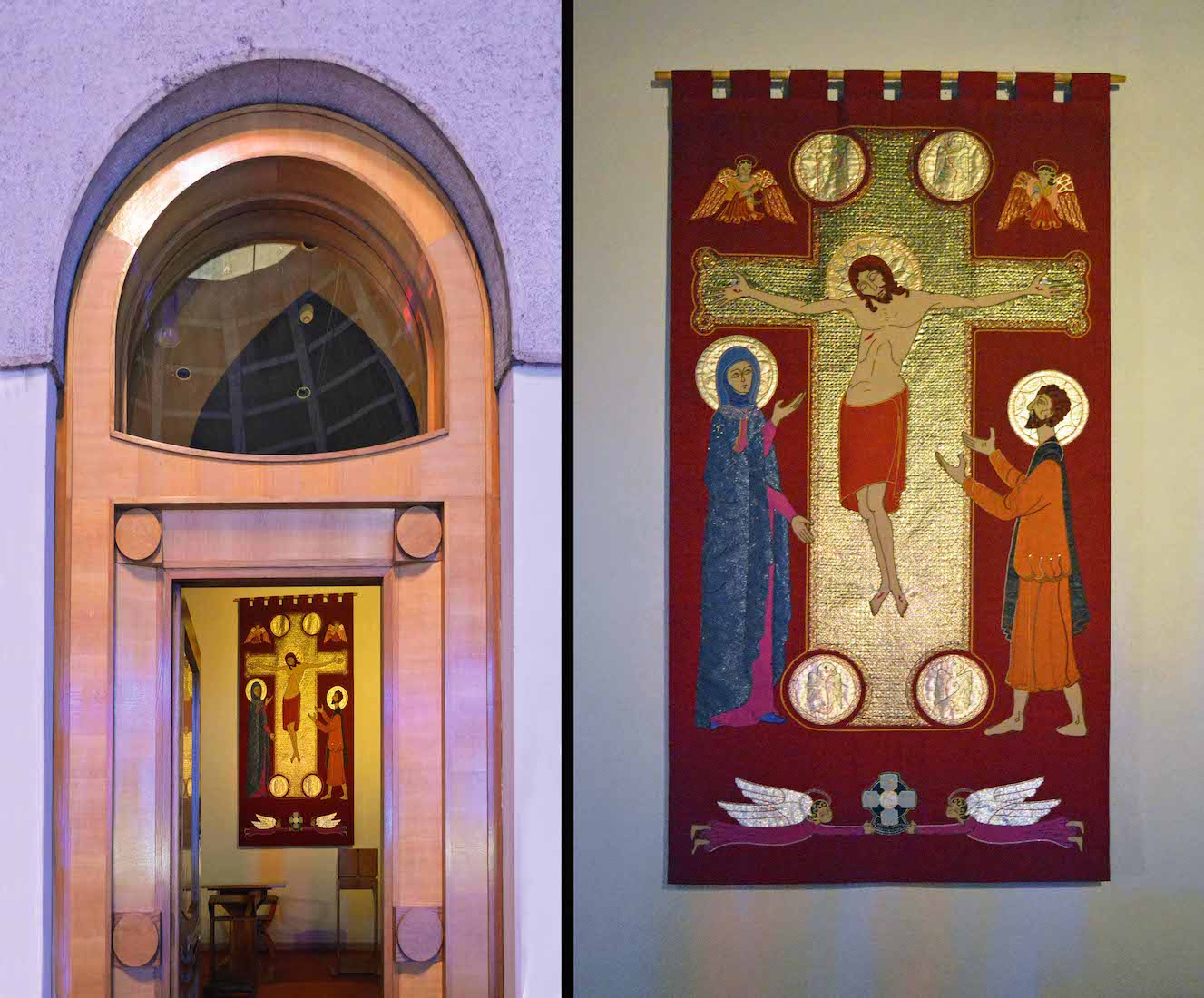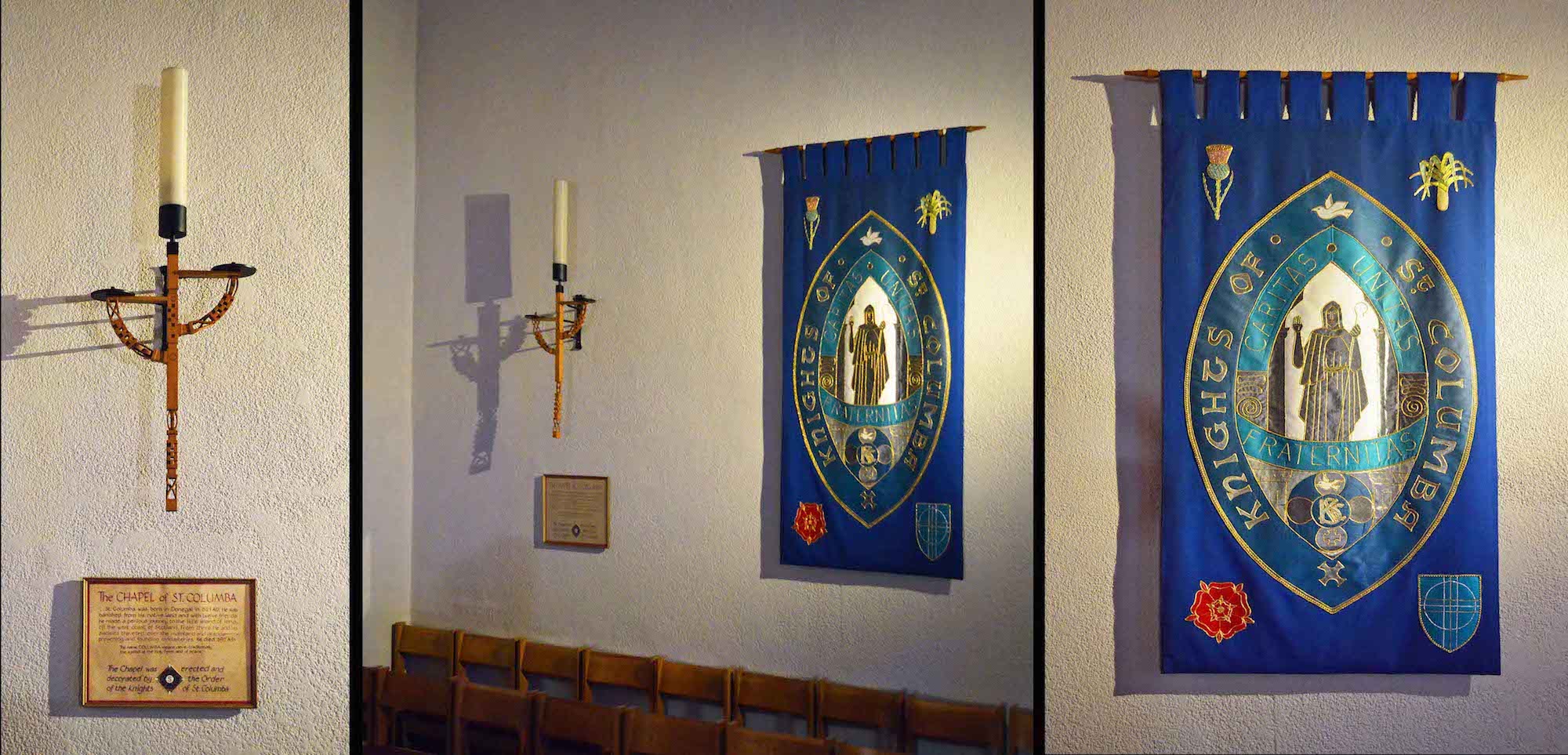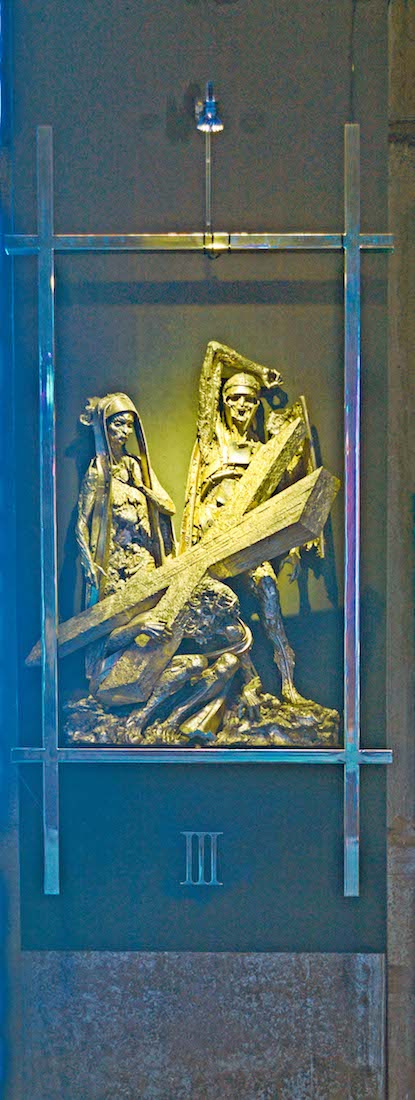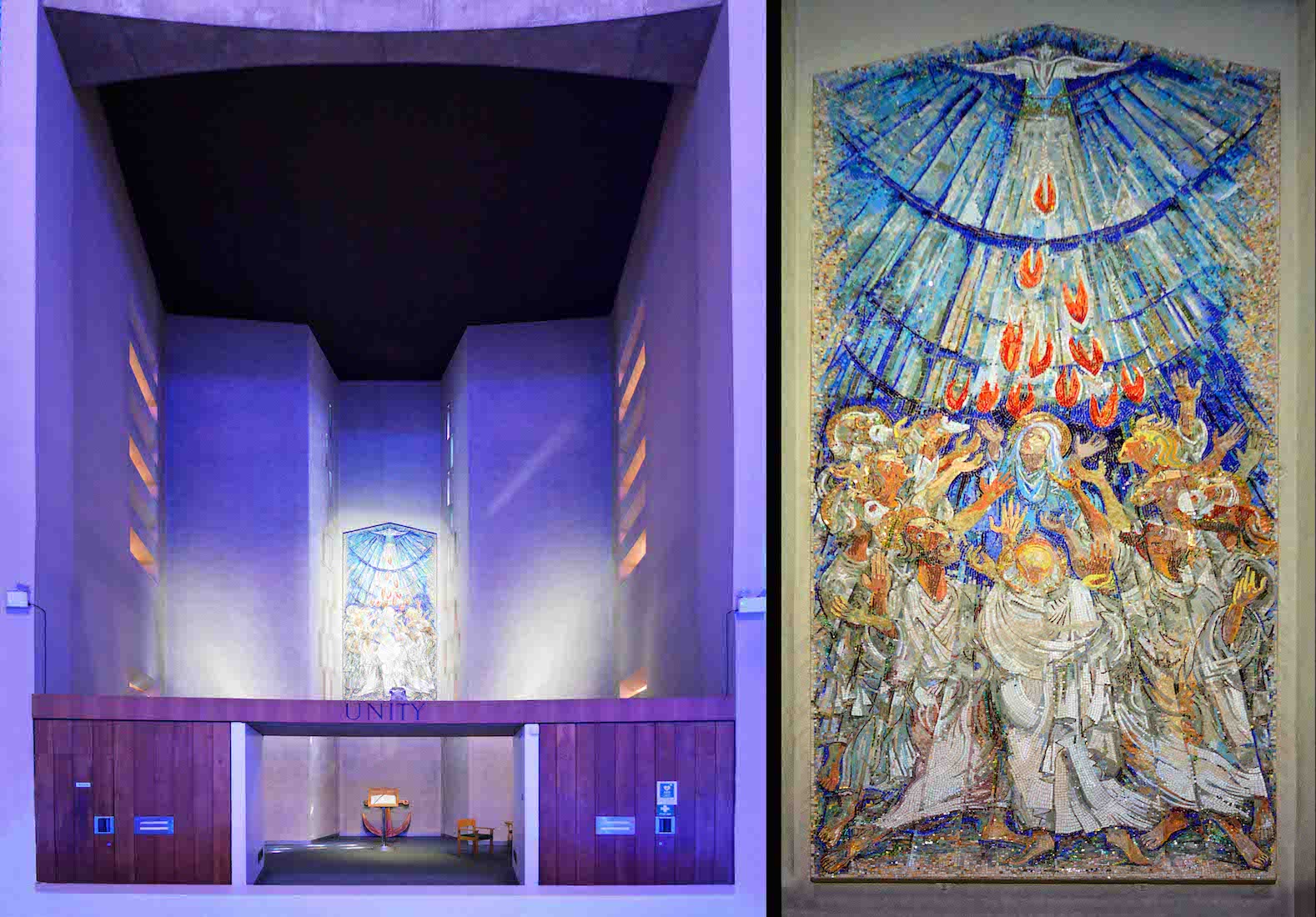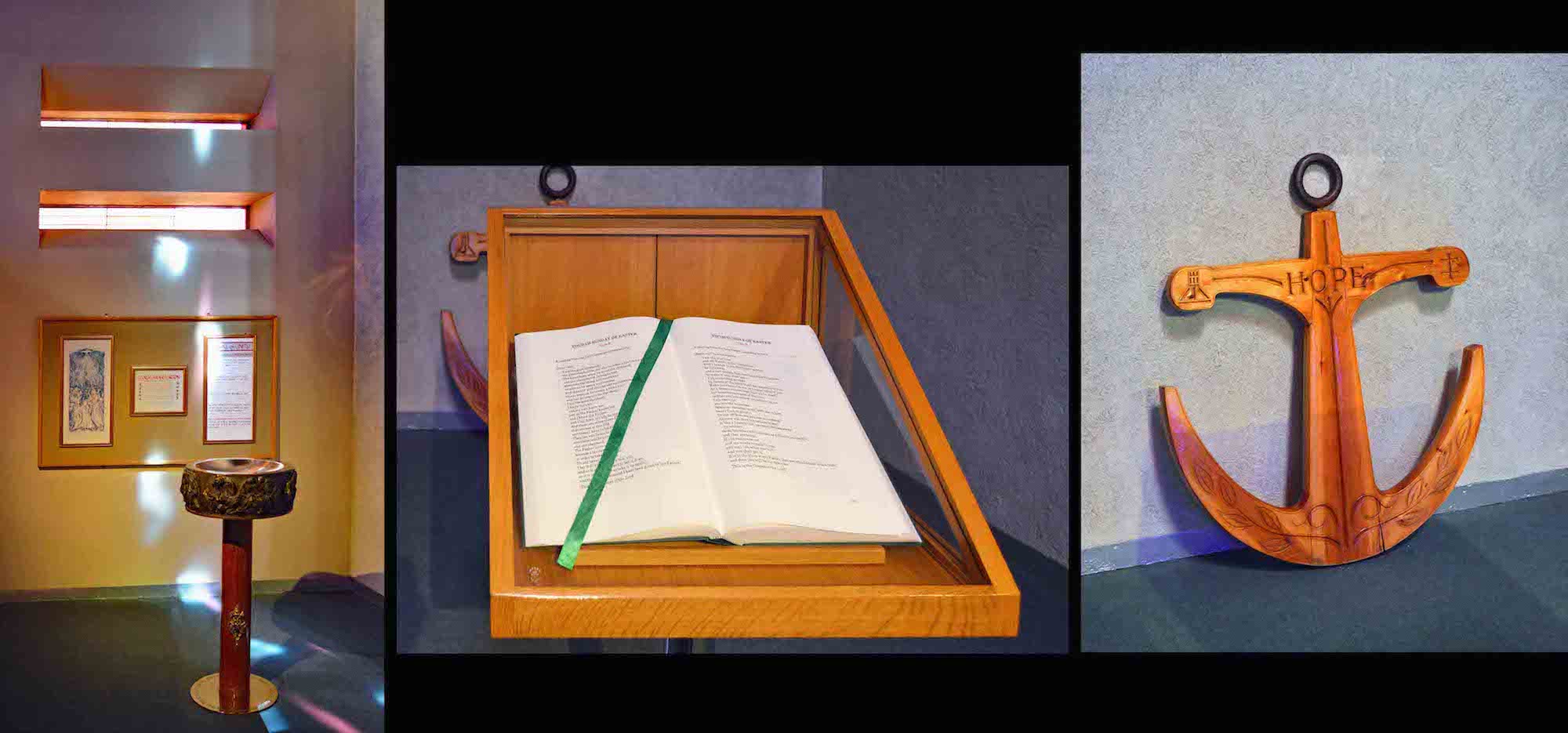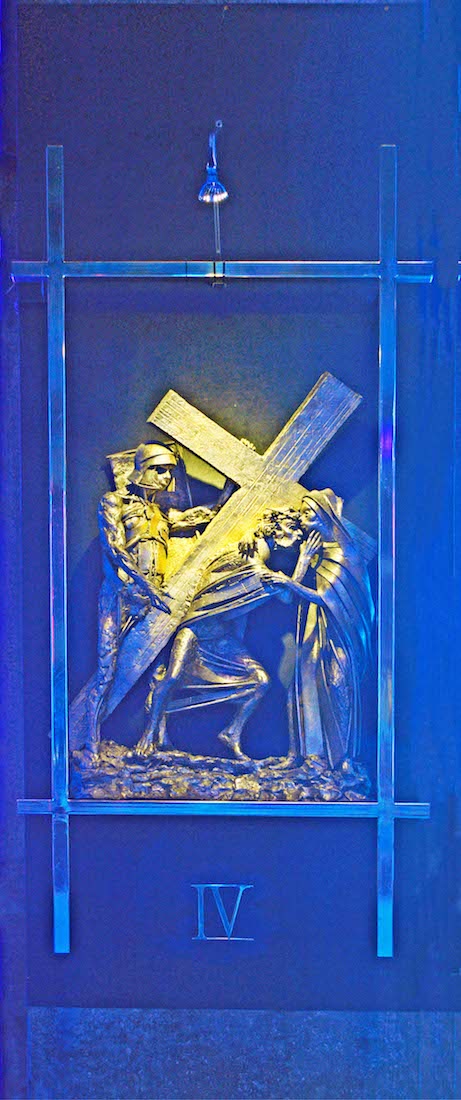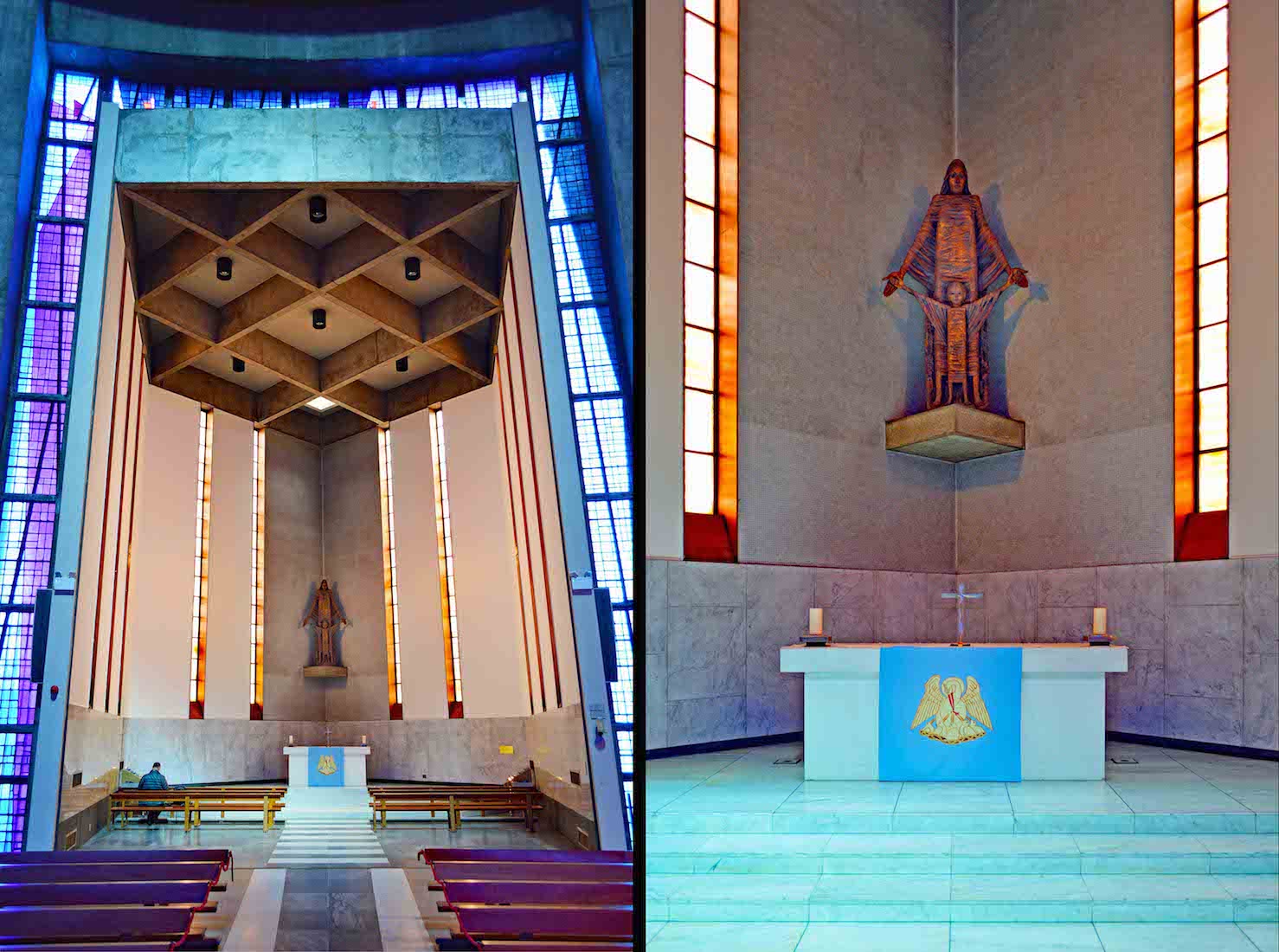
This chapel dedicated to the Virgin Mary, is softly coloured by Margaret Traherne’s rose-tinted windows. In the Catholic Church, the veneration of Mary, mother of Jesus, encompasses various Marian devotions which include prayer, pious acts, visual arts, poetry, and music devoted to the Blessed Virgin Mary. Every Catholic church or cathedral has a Lady Chapel with a focus on Mary. PLAN
42. LADY CHAPEL ALTAR, STATUE
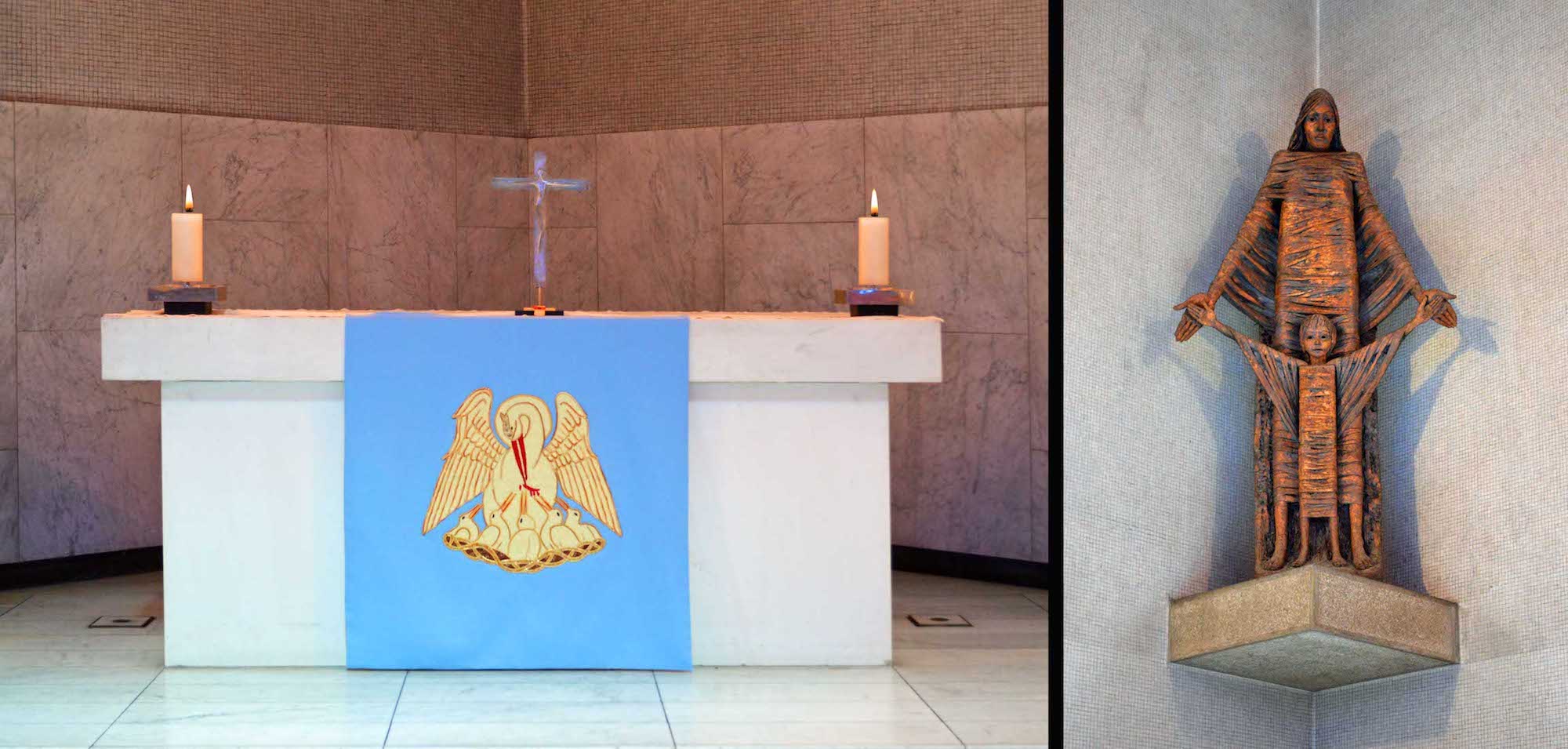
The altar frontal shows a mother pelican feeding her chicks with blood from her pierced breast. Early Christians used this old legend as a picture of the sacrifice of Christ. It is unclear why it has been placed in the Lady Chapel, although perhaps there is an allusion to a mother’s sacrifice.. The chapel contains a ceramic sculpture of the Madonna and Child by Robert Brumby (born 1934).
43. STATION XIII
Most artistic representations of the Crucifixion centre on the figure of Christ on the Cross. Taking the body of a crucified person down from the cross must have been a grisly business. Station XIII : Jesus is taken down from the cross.
44. THE WEST APSE
On either side of the North facing Chapel of the Blessed Sacrament, there is a round section of wall with rows of small rectangular windows. The West Apse is one of these; the other incorporates the descent to the crypt. High on the wall in the West Apse is the coat of arms of Patrick McMahon, OP, KC*HS (born 14 June 1949) who since 2014 has been the (ninth) Archbishop of Liverpool. The motto ‘Non nisi Te’ translates to ‘Only You (Lord)’ – the words of Thomas.
45. ABRAHAM STATUE
In the West Apse is this statue of Abraham, common ancestor of Jews and Arabs, and a symbol of all who believe in the one God. It shows the patriarch about to sacrifice a ram on Mount Moriah in substitution for the life of his only son Isaac. The statue is the work of the local artist Sean Rice..
46. STATION XIV
According to the canonical gospel accounts, the body of Jesus was placed in a tomb by a man named Joseph of Arimathea. A large stone was rolled against the entrance. (Matt 27:57–61). Station XIV : Jesus is placed in the tomb. Traditionally this is the final Station of the Cross. Some churches add a 15th Station relating to the Resurrection of Christ.
47. ORGAN
The Cathedral Grand Organ was designed and built by J W Walker & Sons, in 1967. It has four manuals, 88 speaking stops (108 in all) and 4565 pipes. The action is electro-pneumatic apart from the mechanical swell box links, and the console is situated at the nave level. Built as an integral part of the new Cathedral, the architect Sir Fredrick Gibberd saw the casework as part of his brief and so designed the striking front to the organ. There is also another small one-manual organ in the Blessed Sacrament Chapel.
48. BLESSED SACRAMENT CHAPEL
The mood of this chapel, in which the Blessed Sacrament is preserved, is of recollection, quietness and seclusion. The chapel is the largest of the peripheral chapels. It is lit by two large triangular windows casting light on the altar. The rear wall of the chapel, faced in stone, backs on to the external open-air altar which overlooks the piazza on the north side of the Cathedral.
49. CHAPEL ART AND ALTAR
The golden abstract painted reredos is by Ceri Richards. The tabernacle which houses the Sacrament is recessed in the rear wall directly behind the altar. It is richly ornamented in gilt metal, glass and enamel. The central door of the tabernacle symbolises the glory of God by representing the heavens and constellations. The doors on either side symbolise the Eucharist, depicting the host and the chalice. The bronze figure to the left of the tabernacle represents the Risen Christ and is the work of Liverpool sculptor Arthur Dooley (1929 – 1994).
50. VIEW FROM BEHIND THE ALTAR
From our present position outside the Blessed Sacrament Chapel we can look directly south towards the entrance doors. The organ console is just right of centre.
51. STATION I
In our exploration around the Cathedral we come to the first Station of the Cross. This depicts the scene where Jesus is brought before Pilate. Pilate is weak and orders the Crucifixion of Christ. Here he is shown washing his hands of the whole affair. Station I : Pilate condemns Jesus to die.
52. CRYPT ACCESS
This could be called the East Apse: these doors lead to stairs down to the crypt. The coat of arms here is that of Pope Francis: notice the crossed keys. The motto is ‘Miserando atque eligendo’ (Latin: ‘through the eyes of mercy and choosing ’). Unfortunately, the Cathedral does not allow photography in the crypt – even to those who seek special permission! The reason is unclear, as the crypt is used for many public functions: concerts, a place for examinations, a beer festival!!
53. STATION II
Jesus is now required to carry his Cross to Golgotha, the Place of the Skull, where he will be crucified. Station II : Jesus accepts his cross. We move next to the Chapel of St Columba.
54. CHAPEL OF ST COLUMBA
This is a small intimate chapel dedicated to St Columba, apostle to the north of Britain. It has been designed as a self-contained, silent and dimly-lit place, entered from the nave through a small semi-circular headed doorway. Ahead of us is the Crucifixion Panel showing Christ on the Cross with the Virgin Mary and St John the Evangelist close by. Symbols of the Evangelists are shown, and the angels at the base carry the emblem of the Knights of St Columba who have sponsored the Chapel.
55. INSIDE THE CHAPEL
We turn to the left side of the Chapel. It is lit by small square coloured windows designed by David Atkins. The hanging on the left is in the Celtic style and was designed by Sister Anthony Wilson SND. It shows the figure of the Saint with the island of Iona and the sea monster which threatens his frail coracle in the background. He holds a small church, symbolising the building of the first Christian church in the north. The name Columba means ‘dove’ – the symbol of peace. At right is a banner of the knights of St Columba.
56. FURTHER ROUND THE CHAPEL
The wall to our right has a candlestick and a further banner of the Knights of St Columba. The small plaque acknowledges the contribution of the Knights to the erection of the Chapel, and gives some information about St Columba. He was born in Donegal in 521 AD. He was banished from his native land and with twelve friends he made a perilous journey to the little island of Iona off the west coast of Scotland. From there he and his disciples travelled over the mainland and islands preaching and founding monasteries. He died in 597 AD.
57. STATION III
There is no record in Scripture of Jesus falling on his way to Golgotha, so this event is part of Church tradition. However, it is very likely that Jesus fell. The Stations of the Cross are an aid to devotion, especially around Easter time. Station III : Jesus falls for the first time.
58. UNITY CHAPEL
The next chapel is the Unity Chapel. This chapel is dominated by the great mosaic panel of Pentecost by the Hungarian-born artist George Mayer-Marton who lived 1897 – 1960. The work, carried out in the same manner as the ancient Ravenna mosaics, depicts the Holy Spirit coming upon the assembly of the early Church, with Mary and the apostles caught up in the ecstasy of the revelation. The mosaic was made for the Church of the Holy Ghost in Ford, Liverpool, now demolished, and was moved to the Cathedral in 1988.
59. UNITY CHAPEL DETAILS
The Chapel contains the holy water stoup presented to the Cathedral at its opening by Pope Paul VI, and a lectern on which is displayed the Book of the Gospels. There is also a wooden anchor inscribed with the word ‘Hope’. This is a reference to Hebrews 6:19: ‘We have this hope as an anchor for the soul, firm and secure.’
60. STATION IV
Again, there is no Bible record of Jesus meeting his mother Mary on the way to Golgotha. However, Mary was present at the Crucifixion (John 19:25-27), so it is likely she would have been close by Jesus before this. Station IV : Jesus meets his mother, Mary.


